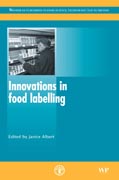
Increasingly, consumers desire information about the health, safety, environmental and socioeconomic characteristics of food products. These traits often cannot be detected by sight, smell or taste. Therefore, consumers must use foodlabels to select products that meet their needs and preferences. The growing consumer and industry interest in food labels presents challenges for governments, which must ensure that the product information is accurate, truthful and not misleading to consumers. Governments must decide whether provision of information should be mandatory or voluntary. With the increase in global trade infood, there is a need to harmonize food labels so that product information isunderstood and relevant to foreign markets. Innovations in food labelling provides information about the principles and requirements of food labelling and reviews the latest trends in this important area. Following an introduction on the evolution of food labelling, further chapters cover the Codex Alimentarius and food labelling, international trade agreements, nutrition labelling, allergies and food labels and environmental and social labels, among other topics. An essential reference for food regulatory agencies, food law experts and professionals in the food industry responsible for labelling as well as consumer and environmental associations with an interest in labelling. INDICE: Introduction to innovations in food labelling J Albert, Food and Agriculture Organization of the United Nations (FAO) Introduction: the evolution of food labelling. Standards and legal issues. Labelling to protect and promote health. Labelling to protect the environment and promote sustainable food production. Labelling to promote social well-being and protect culture. Labelling in relation to new technologies. The Codex Alimentarius and food labelling: delivering consumer protection A R Randell, former Secretary of the Codex Alimentarius Commission Introduction. The Codex framework for food labelling. Specific food labelling issues in the Codex general standard. Claims and other interpretative guidelines. Nutrition labelling: health and nutrition claims. Labelling, food safety and allergens. Foods derived from biotechnology. Codex, labelling and advertising. Conclusions. References. International legal frameworks for food labelling and consumer rights M Vidar, Food and Agriculture Organization of the United Nations (FAO) Introduction. International human rights law. Consumer protection. International trade agreements. Acknowledgement. References. Government and voluntary policies on nutrition labelling: a global overview C Hawkes, Independent Consultant, Food and Nutrition Policy Introduction. Nutrition facts tables. Graphical nutrition labelling. Trends. Conclusions. References. Labelling of allergenic foods of concern in Europe S Hattersley and C-H Chan, UK Food Standards Agency Introduction. Drivers behind the development of specific EU allergen labelling legislation. Exemptions for certain processed ingredients derived from the specified allergenic foods. Other allergen information that manufacturers can choose to put on food packaging. Possible legislative developments in the future, including foods sold non-prepacked. Foods sold as 'free from'. Conclusions. References. Organic food labels: history and latest trends A Compagnoni, Institute for Ethical and Environmental Certification (ICEA) Introduction. Organic agriculture definition. From alternative movement to international and national legislations. From niche to mainstream market. Main normative frame. Codex Alimentarius organic norm. International federation of organic agriculture movements (IFOAM) organic norms. Private standards. European Union organic regulation. United States organic rules (National Organic Program). Japanese agricultural standard (JAS) of organic agricultural products. International Task Force for organic regulations harmonization and equivalence. Some examples of public and private organic labels and logos. References. FAO's ecolabelling guidelines for marine capture fisheries: an international standard R Willmann, K Cochrane and W Emerson, Food and Agriculture Organization of the United Nations (FAO) Introduction. Why ecolabelling. History of the FAO ecolabelling guidelines for fish and fishery products. The development of the FAO ecolabelling guidelines. Conclusions. References. Voluntary environmental and social labels in the food sector P Liu, Food and AgricultureOrganization of the United Nations (FAO) Introduction. Background: environmental and social issues in agriculture. Main environmental and social labelling schemes in agriculture. Fair-trade. Main markets for labelled foods. Benefits and costs for producers. Case study: organic bananas. Case study: Fairtrade-labelled coffee. Conclusions. References. Geographic origin and identification labels: associating food quality with location E Vandecandelaere, Food and Agriculture Organization of the United Nations (FAO) Introduction. Labels on quality linked to geographical origin: rules and diversity in the international context. The reasons of development of geographical indications. Setting up a GI label: a two level approach. Conclusions. Acknowledgements. References. New technologies and food labelling: the controversy over labelling of foods derivedfrom genetically modified crops J Albert, Food and Agriculture Organization of the United Nations (FAO) Agricultural biotechnology and consumers. Policy options. Commercial experiences with labelling. Conclusions. References.
- ISBN: 978-1-84569-676-4
- Editorial: Woodhead
- Encuadernacion: Cartoné
- Páginas: 184
- Fecha Publicación: 30/12/2009
- Nº Volúmenes: 1
- Idioma: Inglés
